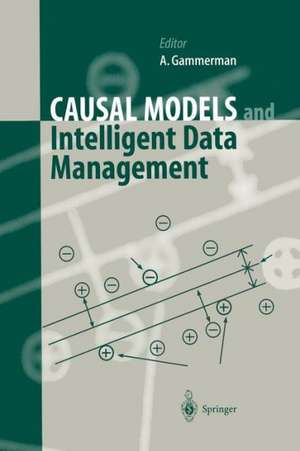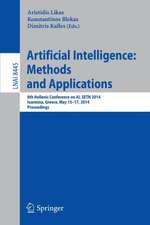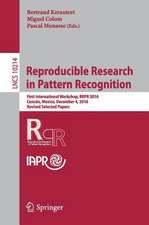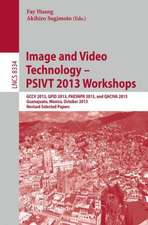Causal Models and Intelligent Data Management
Editat de Alex Gammermanen Limba Engleză Paperback – 28 oct 2012
| Toate formatele și edițiile | Preț | Express |
|---|---|---|
| Paperback (1) | 327.62 lei 6-8 săpt. | |
| Springer Berlin, Heidelberg – 28 oct 2012 | 327.62 lei 6-8 săpt. | |
| Hardback (1) | 330.42 lei 6-8 săpt. | |
| Springer Berlin, Heidelberg – 18 aug 1999 | 330.42 lei 6-8 săpt. |
Preț: 327.62 lei
Preț vechi: 409.52 lei
-20% Nou
Puncte Express: 491
Preț estimativ în valută:
62.69€ • 65.59$ • 52.08£
62.69€ • 65.59$ • 52.08£
Carte tipărită la comandă
Livrare economică 02-16 aprilie
Preluare comenzi: 021 569.72.76
Specificații
ISBN-13: 9783642636820
ISBN-10: 3642636829
Pagini: 200
Ilustrații: X, 185 p.
Dimensiuni: 155 x 235 x 11 mm
Greutate: 0.29 kg
Ediția:Softcover reprint of the original 1st ed. 1999
Editura: Springer Berlin, Heidelberg
Colecția Springer
Locul publicării:Berlin, Heidelberg, Germany
ISBN-10: 3642636829
Pagini: 200
Ilustrații: X, 185 p.
Dimensiuni: 155 x 235 x 11 mm
Greutate: 0.29 kg
Ediția:Softcover reprint of the original 1st ed. 1999
Editura: Springer Berlin, Heidelberg
Colecția Springer
Locul publicării:Berlin, Heidelberg, Germany
Public țintă
Professional/practitionerDescriere
Data analysis and inference have traditionally been research areas of statistics. However, the need to electronically store, manipulate and analyze large-scale, high-dimensional data sets requires new methods and tools, new types of databases, new efficient algorithms, new data structures, etc. - in effect new computational methods.
This monograph presents new intelligent data management methods and tools, such as the support vector machine, and new results from the field of inference, in particular of causal modeling. In 11 well-structured chapters, leading experts map out the major tendencies and future directions of intelligent data analysis. The book will become a valuable source of reference for researchers exploring the interdisciplinary area between statistics and computer science as well as for professionals applying advanced data analysis methods in industry and commerce. Students and lecturers will find the book useful as an introduction to the area.
This monograph presents new intelligent data management methods and tools, such as the support vector machine, and new results from the field of inference, in particular of causal modeling. In 11 well-structured chapters, leading experts map out the major tendencies and future directions of intelligent data analysis. The book will become a valuable source of reference for researchers exploring the interdisciplinary area between statistics and computer science as well as for professionals applying advanced data analysis methods in industry and commerce. Students and lecturers will find the book useful as an introduction to the area.
Cuprins
I. Causal Models.- 1. Statistics, Causality, and Graphs.- 1.1 A Century of Denial.- 1.2 Researchers in Search of a Language.- 1.3 Graphs as a Mathematical Language.- 1.4 The Challenge.- References.- 2. Causal Conjecture.- 2.1 Introduction.- 2.2 Variables in a Probability Tree.- 2.3 Causal Uncorrelatedness.- 2.4 Three Positive Causal Relations.- 2.5 Linear Sign.- 2.6 Causal Uncorrelatedness Again.- 2.7 Scored Sign.- 2.8 Tracking.- References.- 3. Who Needs Counterfactuals?.- 3.1 Introduction.- 3.1.1 Decision-Theoretic Framework.- 3.1.2 Unresponsiveness and Insensitivity.- 3.2 Counterfactuals.- 3.3 Problems of Causal Inference.- 3.3.1 Causes of Effects.- 3.3.2 Effects of Causes.- 3.4 The Counterfactual Approach.- 3.4.1 The Counterfactual Setting.- 3.4.2 Counterfactual Assumptions.- 3.5 Homogeneous Population.- 3.5.1 Experiment and Inference.- 3.6 Decision-Analytic Approach.- 3.7 Sheep and Goats.- 3.7.1 ACE.- 3.7.2 Neyman and Fisher.- 3.7.3 Bioequivalence.- 3.8 Causes of Effects.- 3.8.1 A Different Approach?.- 3.9 Conclusion.- References.- 4. Causality: Independence and Determinism.- 4.1 Introduction.- 4.2 Conclusion.- References.- II. Intelligent Data Management.- 5. Intelligent Data Analysis and Deep Understanding.- 5.1 Introduction.- 5.2 The Question: The Strategy.- 5.3 Diminishing Returns.- 5.4 Conclusion.- References.- 6. Learning Algorithms in High Dimensional Spaces.- 6.1 Introduction.- 6.2 SVM for Pattern Recognition.- 6.2.1 Dual Representation of Pattern Recognition.- 6.3 SVM for Regression Estimation.- 6.3.1 Dual Representation of Regression Estimation.- 6.3.2 SVM Applet and Software.- 6.4 Ridge Regression and Least Squares Methods in Dual Variables.- 6.5 Transduction.- 6.6 Conclusion.- References.- 7. Learning Linear Causal Models by MML Sampling.- 7.1 Introduction.- 7.2 Minimum Message Length Principle.- 7.3 The Model Space.- 7.4 The Message Format.- 7.5 Equivalence Sets.- 7.5.1 Small Effects.- 7.5.2 Partial Order Equivalence.- 7.5.3 Structural Equivalence.- 7.5.4 Explanation Length.- 7.6 Finding Good Models.- 7.7 Sampling Control.- 7.8 By-products.- 7.9 Prior Constraints.- 7.10 Test Results.- 7.11 Remarks on Equivalence.- 7.11.1 Small Effect Equivalence.- 7.11.2 Equivalence and Causality.- 7.12 Conclusion.- References.- 8. Game Theory Approach to Multicommodity Flow Network Vulnerability Analysis.- References.- 9. On the Accuracy of Stochastic Complexity Approximations.- 9.1 Introduction.- 9.2 Stochastic Complexity and Its Applications.- 9.3 Approximating the Stochastic Complexity in the Incomplete Data Case.- 9.4 Empirical Results.- 9.4.1 The Problem.- 9.4.2 The Experimental Setting.- 9.4.3 The Algorithms.- 9.4.4 Results.- 9.5 Conclusion.- References.- 10. AI Modelling for Data Quality Control Xiaohui Liu.- 10.1 Introduction.- 10.2 Statistical Approaches to Outliers.- 10.3 Outlier Detection and Analysis.- 10.4 Visual Field Test.- 10.5 Outlier Detection.- 10.5.1 Self-Organising Maps (SOM).- 10.5.2 Applications of SOM.- 10.6 Outlier Analysis by Modelling ‘Real Measurements’.- 10.7 Outlier Analysis by Modelling Noisy Data.- 10.7.1 Noise Model I: Noise Definition.- 10.7.2 Noise Model II: Construction.- 10.7.3 Noise Elimination.- 10.8 Concluding Remarks.- References.- 11. New Directions in Text Categorization.- 11.1 Introduction.- 11.2 Machine Learning for Text Classification.- 11.3 Radial Basis Functions and the Bard.- 11.4 An Evolutionary Algorithm for Text Classification.- 11.5 Text Classification by Vocabulary Richness.- 11.6 Text Classification with Frequent Function Words.- 11.7 Do Authors Have Semantic Signatures?.- 11.8 Syntax with Style.- 11.9 Intermezzo.- 11.10 Some Methods of Textual Feature-Finding.- 11.10.1 Progressive Pairwise Chunking.- 11.10.2 Monte Carlo Feature Finding.- 11.10.3 How Long Is a Piece of Substring?.- 11.10.4 Comparative Testing.- 11.11 Which Methods Work Best? - A Benchmarking Study.- 11.12 Discussion.- 11.12.1 In Praise of Semi-Crude Bayesianism.- 11.12.2 What's So Special About Linguistic Data?.- References.
Caracteristici
Coherent survey on new intelligent data analysis methods with an emphasis on causal inference
Based on courses held by UNICOM
Includes supplementary material: sn.pub/extras
Based on courses held by UNICOM
Includes supplementary material: sn.pub/extras


























